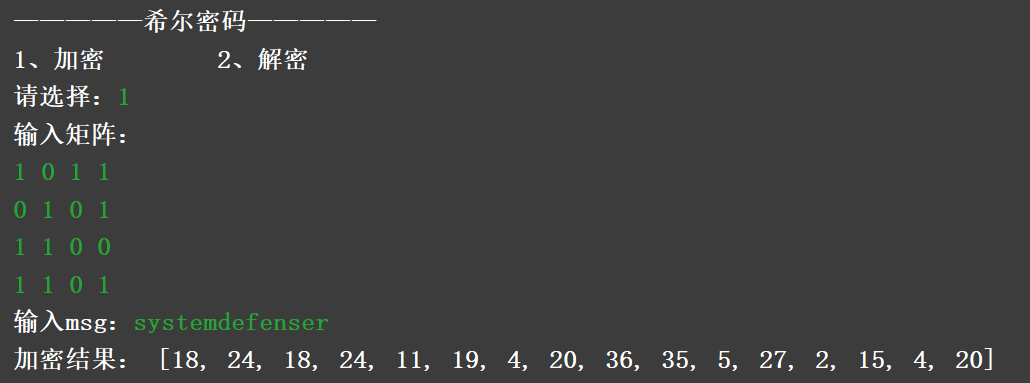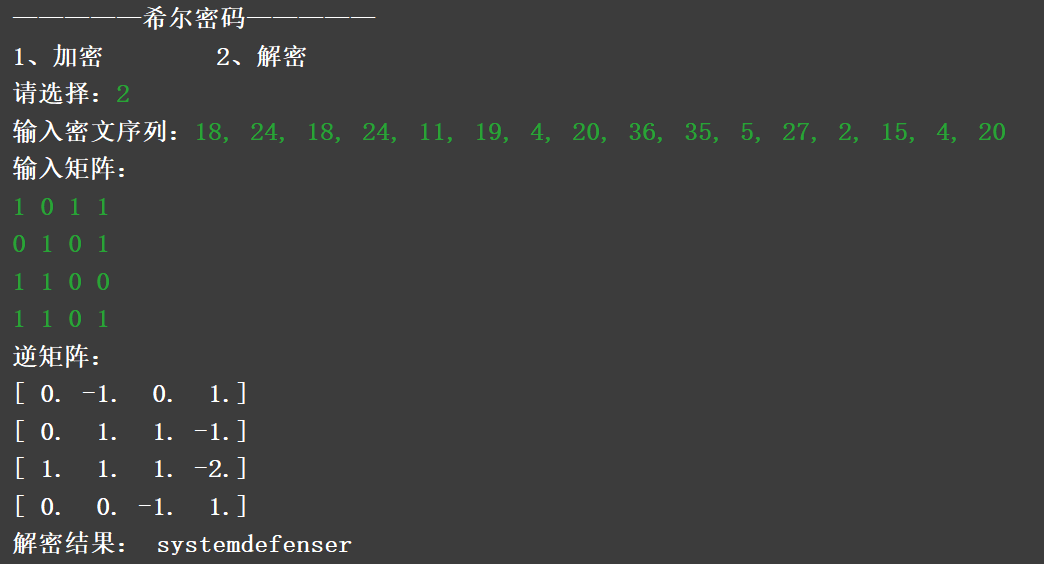简述
希尔密码是利用矩阵进行加密的一种加密算法,其本质是一种多表代换密码。
- 百科:
希尔密码是运用基本矩阵论原理的替换密码,由Lester S. Hill在1929年发明。
每个字母当作26进制数字:A=0, B=1, C=2… 一串字母当成n维向量,跟一个n×n的矩阵相乘,再将得出的结果模26。
注意用作加密的矩阵(即密匙)在 必须是可逆的,否则就不可能解码。只有矩阵的行列式和26互质,才是可逆的。
希尔密码由于采用矩阵运算加密,因此在相同的明文加密时,可能会出现不同的密文,因此可以很好的抵御字母频率攻击法。
加解密
1、定义一个矩阵a(须存在逆矩阵)作为加密密钥:
[1,2,1]
[0,2,1]
[1,0,2]
2、将需要加密的明文字母转换为其对应的字母表数字(1-a,2-b……);
3、将转换后的明文数字序列按照密钥矩阵的阶数进行分组(如本次为3个字符一组);
4、每组数字序列和密钥矩阵进行矩阵的乘法运算(1x3 矩阵乘以 3x3矩阵),结果即为密文数字序列;
5、可将密文数字序列转换为其对应字母,即为密文字符串。
解密流程与加密相同,唯一不同之处在于:需先求出加密密钥的逆矩阵
在做矩阵相成时,用密文分组乘以逆矩阵,结果即为明文
代码实现
1
2
3
4
5
6
7
8
9
10
11
12
13
14
15
16
17
18
19
20
21
22
23
24
25
26
27
28
29
30
31
32
33
34
35
36
37
38
39
40
41
42
43
44
45
46
47
48
49
50
51
52
53
54
55
56
57
58
59
60
61
62
63
64
65
66
67
68
69
70
71
72
73
74
75
76
77
78
79
80
81
82
83
84
85
86
87
88
89
90
91
92
93
94
95
96
97
98
99
100
101
102
103
104
105
106
107
108
109
110
111
112
113
114
115
116
117
118
119
120
121
122
123
124
125
126
127
128
129
130
131
132
133
134
135
136
137
138
139
140
141
142
143
144
|
from numpy import linalg
def inputMatrix():
while True:
rank = list(input("").split())
matrix = [[0] * len(rank) for i in range(len(rank))]
matrix[0] = rank
for i in range(1, len(matrix)):
matrix[i] = list(input("").split())
if len(matrix[i]) != len(matrix):
print("输入有误,重新输入。")
continue
for i in range(len(matrix)):
matrix[i] = list(map(lambda x: int(x), matrix[i]))
if not judgeInverse(matrix):
print("矩阵不存在逆矩阵,重新输入。")
continue
return matrix
def judgeInverse(matrix):
try:
linalg.inv(matrix)
except:
return False
return True
def createMatrixInverse(matrix):
try:
matrix_inverse = linalg.inv(matrix)
except:
return -1
return matrix_inverse
def createMassageList(massage, matrix):
matrixRank = len(matrix)
massageList = []
while len(massage) % matrixRank != 0:
massage += " "
for i in range(1, len(massage) + 1, matrixRank):
massageList.append(massage[i-1:i + matrixRank - 1])
return massageList
def letterToDigit(massageList):
massageDigitList = []
letterList = []
for i in range(ord("a"), ord("z") + 1):
letterList.append(chr(i))
for i in range(10):
letterList.append(str(i))
letterList.append(" ")
for massage in massageList:
listTmp = []
for i in range(len(massage)):
listTmp.append(letterList.index(massage[i]))
massageDigitList.append(listTmp)
return massageDigitList
def digitToLetter(massageList):
massageLetterList = []
letterList = []
for i in range(ord("a"), ord("z") + 1):
letterList.append(chr(i))
for i in range(10):
letterList.append(str(i))
letterList.append(" ")
for massage in massageList:
massageLetterList.append(letterList[massage % 37])
return massageLetterList
def encrypt(massage, matrix):
ciphertextList = []
massageList = createMassageList(massage, matrix)
massageDigitList = letterToDigit(massageList)
for massageDigit in massageDigitList:
for i in range(len(massageDigit)):
sum = 0
for j in range(len(massageDigit)):
sum += massageDigit[j] * matrix[j][i % len(matrix)]
ciphertextList.append(sum % 37)
return ciphertextList
def decrypt(massage, matrix):
plaintextList = []
matrix_inverse = createMatrixInverse(matrix)
massageList = createMassageList(massage, matrix)
for msg in massageList:
for i in range(len(msg)):
sum = 0
for j in range(len(msg)):
sum += msg[j] * matrix_inverse[j][i % len(matrix)]
plaintextList.append(sum % 37)
plaintextList = list(map(lambda x: int(round(x)), plaintextList))
plaintextList = digitToLetter(plaintextList)
plaintext = ""
for item in plaintextList:
plaintext += item
return plaintext
if __name__ == "__main__":
while True:
print("—————希尔密码—————")
choice = input("1、加密 2、解密\n请选择:")
if choice == "1":
print("输入矩阵:")
matrix = inputMatrix()
massage = input("输入msg:")
massageList = createMassageList(massage, matrix)
ciphertextList = encrypt(massage, matrix)
print("加密结果:", ciphertextList)
elif choice == "2":
massageList = list(map(int, list(input("输入密文序列:").split(","))))
print("输入矩阵:")
matrix = inputMatrix()
matrix_inverse = createMatrixInverse(matrix)
print("逆矩阵:")
for item in matrix_inverse:
print(item)
plaintext = decrypt(massageList, matrix)
print("解密结果:", plaintext)
|
其中,求逆矩阵部分未能手算,调用了numpy库中的linalg函数,惭愧………………
加密测试
1
2
3
4
5
6
7
8
9
10
11
12
13
14
15
16
17
18
19
20
21
22
23
24
25
| —————希尔密码—————
1、加密 2、解密
请选择:1
输入矩阵:
1 0 1 1
0 1 0 1
1 1 0 0
1 1 0 1
输入msg:systemdefenser
加密结果: [18, 24, 18, 24, 11, 19, 4, 20, 36, 35, 5, 27, 2, 15, 4, 20]
—————希尔密码—————
1、加密 2、解密
请选择:2
输入密文序列:18, 24, 18, 24, 11, 19, 4, 20, 36, 35, 5, 27, 2, 15, 4, 20
输入矩阵:
1 0 1 1
0 1 0 1
1 1 0 0
1 1 0 1
逆矩阵:
[ 0. -1. 0. 1.]
[ 0. 1. 1. -1.]
[ 1. 1. 1. -2.]
[ 0. 0. -1. 1.]
解密结果: systemdefenser
|


部分代码详解
代码片段:
1
2
3
4
5
6
7
8
9
10
11
12
| while True:
rank = list(input("").split())
matrix = [[0] * len(rank) for i in range(len(rank))]
matrix[0] = rank
for i in range(1, len(matrix)):
matrix[i] = list(input("").split())
if len(matrix[i]) != len(matrix):
print("输入有误,重新输入。")
continue
|
该片段位于 inputMatrix() 函数中。
输入矩阵部分未让用户先定义阶数,而是通过用户输入的矩阵第一行,来决定本次迷药矩阵的阶数,并且不断进行合法判断。
代码片段:
1
2
3
|
plaintextList = list(map(lambda x: int(round(x)), plaintextList))
plaintextList = digitToLetter(plaintextList)
|
该片段位于 decrypt(massage, matrix) 函数中。
由于逆矩阵存在不可约分或整除的小数,因此在此处采用四舍五入round(x) 的方法不严谨地解决此问题。


